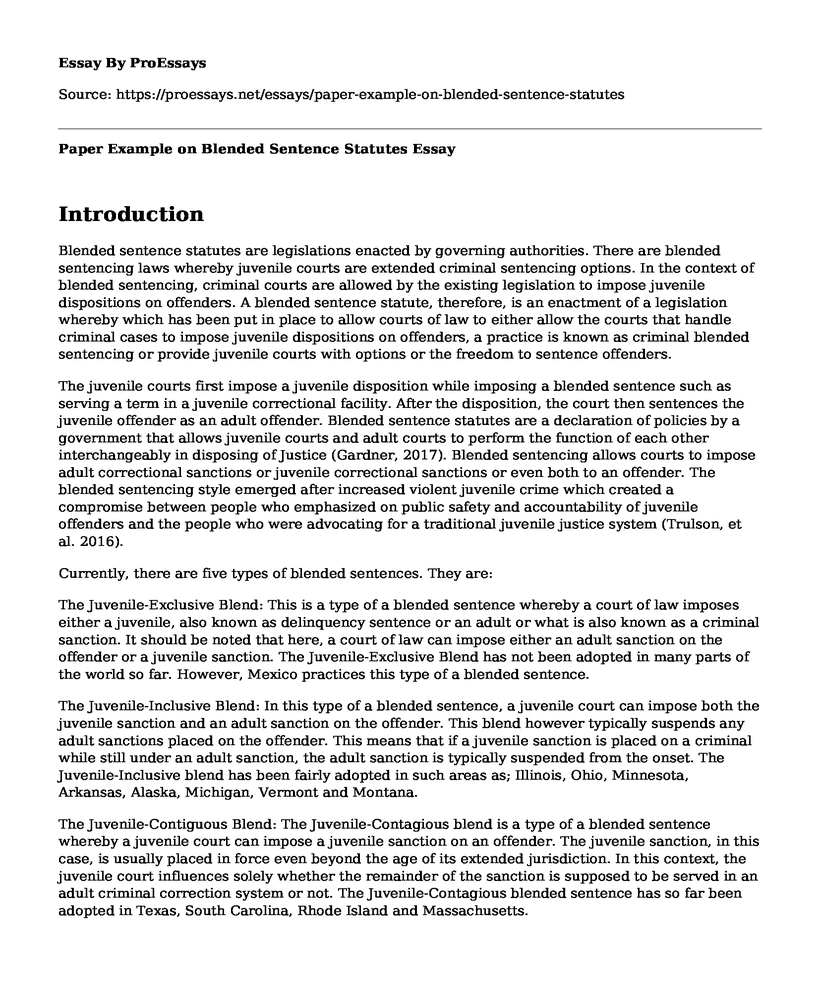Introduction
Blended sentence statutes are legislations enacted by governing authorities. There are blended sentencing laws whereby juvenile courts are extended criminal sentencing options. In the context of blended sentencing, criminal courts are allowed by the existing legislation to impose juvenile dispositions on offenders. A blended sentence statute, therefore, is an enactment of a legislation whereby which has been put in place to allow courts of law to either allow the courts that handle criminal cases to impose juvenile dispositions on offenders, a practice is known as criminal blended sentencing or provide juvenile courts with options or the freedom to sentence offenders.
The juvenile courts first impose a juvenile disposition while imposing a blended sentence such as serving a term in a juvenile correctional facility. After the disposition, the court then sentences the juvenile offender as an adult offender. Blended sentence statutes are a declaration of policies by a government that allows juvenile courts and adult courts to perform the function of each other interchangeably in disposing of Justice (Gardner, 2017). Blended sentencing allows courts to impose adult correctional sanctions or juvenile correctional sanctions or even both to an offender. The blended sentencing style emerged after increased violent juvenile crime which created a compromise between people who emphasized on public safety and accountability of juvenile offenders and the people who were advocating for a traditional juvenile justice system (Trulson, et al. 2016).
Currently, there are five types of blended sentences. They are:
The Juvenile-Exclusive Blend: This is a type of a blended sentence whereby a court of law imposes either a juvenile, also known as delinquency sentence or an adult or what is also known as a criminal sanction. It should be noted that here, a court of law can impose either an adult sanction on the offender or a juvenile sanction. The Juvenile-Exclusive Blend has not been adopted in many parts of the world so far. However, Mexico practices this type of a blended sentence.
The Juvenile-Inclusive Blend: In this type of a blended sentence, a juvenile court can impose both the juvenile sanction and an adult sanction on the offender. This blend however typically suspends any adult sanctions placed on the offender. This means that if a juvenile sanction is placed on a criminal while still under an adult sanction, the adult sanction is typically suspended from the onset. The Juvenile-Inclusive blend has been fairly adopted in such areas as; Illinois, Ohio, Minnesota, Arkansas, Alaska, Michigan, Vermont and Montana.
The Juvenile-Contiguous Blend: The Juvenile-Contagious blend is a type of a blended sentence whereby a juvenile court can impose a juvenile sanction on an offender. The juvenile sanction, in this case, is usually placed in force even beyond the age of its extended jurisdiction. In this context, the juvenile court influences solely whether the remainder of the sanction is supposed to be served in an adult criminal correction system or not. The Juvenile-Contagious blended sentence has so far been adopted in Texas, South Carolina, Rhode Island and Massachusetts.
The Criminal-Exclusive blend: The Juvenile-Contagious sentence blend is a type of blend whereby a criminal court has the jurisdiction to impose both juvenile sanctions and criminal sanctions. Under the criminal-exclusive blend, the criminal sanction is typically suspended. The court has the mandate to impose both the juvenile and criminal sanctions on an offender. This type of a blended sentence is currently in practice in such States as Arkansas, Missouri, Virginia, Idaho, Michigan and Florida.
Resources
Gardner, M. R. (2017). Indeterminate Sanctions, Juvenile Court. The Encyclopedia of Juvenile Delinquency and Justice, 1-5.
Trulson, C. R., Haerle, D. R., Caudill, J. W., & DeLisi, M. (2016). Lost causes: Blended sentencing, second chances, and the Texas youth commission. University of Texas Press.
Cite this page
Paper Example on Blended Sentence Statutes. (2022, Jul 01). Retrieved from https://proessays.net/essays/paper-example-on-blended-sentence-statutes
If you are the original author of this essay and no longer wish to have it published on the ProEssays website, please click below to request its removal:
- Non Verbal Cues in Martin Luther King's Speech Essay
- Analysis on Death Penalty Paper Example
- Increasing Gun-Related Violence Essay Example
- Trevor Noah: Surviving Apartheid in South Africa - Essay Sample
- Richard Ramirez Crimes Case Study Paper Example
- Essay Example on Abortion Debate: Pro-Choice and Pro-Life Views in 2021
- War on Compassion: The Impact of Massification - Free Report Sample







